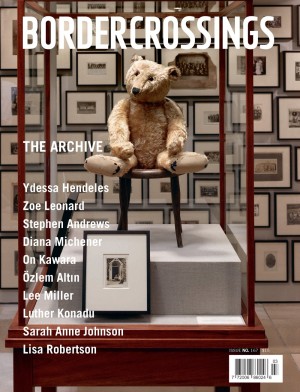Henrike Naumann
Six steer horns extend upwards in delicate and expanded spiral geometries like mutant growth projected from the upholstered back of an otherwise discreet sitting chair. Four more cattle horns reach below to support the chair from its underside: the sharp points of the animal relics brutishly scrape against the cement floor of Long Island City’s SculptureCenter. The “horn chair,” notable as the exhibition’s most cruel yet seemingly most desirable for visitors, is one of 13 that together compose Berlin-based artist Henrike Naumann’s sculptural assemblage Horseshoe Theory, 2022, an intense and relentless opening work for the artist’s debut US exhibition, “Re-Education.”
Concerned with political extremism and its complicated relationship with place, Naumann’s work develops through an obsessive and rigorous process of research and collection in dialogue with cultural, political and spatial locality. All of the objects in the exhibition, mostly found furniture, banal and extreme—19th-century office cabinets and desks, chairs, pitchforks, cartoonish animal bones and boulders—were determined and collected only after Naumann had arrived in New York in the months leading up to the exhibition’s opening. Sourced from New York to rural Georgia to American e-commerce site Wayfair.com, this amalgam of furniture feels entirely at home in her installation at SculptureCenter, which she staged to evoke natural emergence. The space feels cavernous, uncanny in “Re-Education.” Interior partitions, flooring, industrial emptiness and material elements don’t feel like existing art-space architectural components and, like the furniture, are treated as objects charged with mysterious histories and ominous potential.

Henrike Naumann, Horseshoe Theory (detail), 2022. Photo: Charles Benton. Courtesy the artist.
In Horseshoe Theory, as in much of the artist’s work, verbal political language is both dissolved into immaterial atmosphere and distinctly formalized as found design objects and architectural stagings that become frames for political configurations. The “horseshoe theory,” developed in Germany in the 1930s, contorts a linear political spectrum of “right” and “left” into a near loop, a horseshoe, in a gesture suggesting a resemblance between oppositional political ideologies. Constructing political discontent into physical space, Naumann uses the contended political theory as a ready-made organizational form to reframe design objects as political proxies: “oppressive traditionalism,” for instance, materializes into the fascist brutality of disembodied animal life functionalized into domestic seating decor.
Structured processionally as a series of large-scale works simultaneously inhabitable as architectural spaces and delicately arranged images of them, the exhibition feels something like a prophetic crystal ball mischievously leading viewers further into a mythologized American future. Adjacent to the political extremism expressed through seating objects in Horseshoe Theory looms Naumann’s towering Rustic Traditions, 2022.

Henrike Naumann, installation view, “Henrike Naumann: Re-Education,” 2022, SculptureCenter, New York. Photo: Charles Benton. Courtesy the artist.
This monumental work succeeds as a sculptural form in establishing new materiality for discussing the January 6 United States Capitol attack, while also proposing a fictionalized yet unsettlingly convincing alternative outcome. Ascending towards the gallery’s ceilings and resonating with the cold darkness of intricately stacked federal furniture and harsh agricultural tools (which seem more like weapons, here), this menacing work stands as a memorial to a destroyed American population and an accidental artifact of a violent coup. This assembly of furniture appears almost as an attempted barrier, a failed barricade that couldn’t stop what was to come.
Working like a conspiracy theorist (or, using one’s methods as a ready-made process), Naumann’s practice interrogates fact and evidence. The artist traces and digs, uncovering latent throughlines to stage apophenic, sinister theories tightly braided into the geopolitical sites she works in. This method inscribes itself into the exhibition’s peculiarly paranoid haze, too: I’ve never been inside a conspiracy theorist’s working space, but I think it may offer something like Naumann’s exhibition. And, despite the particularity of Naumann’s articulated austerity, the individual objects collected for the exhibition were gathered in the same way you or I might find them for our own spaces: through the familiar process of endlessly scrolling Craigslist or Facebook Marketplace, standard methods for interior furnishing, popular protocols for identity assembly and aestheticization. While the spaces and objects of “Re-Education” feel alien, they’re constantly grounded by Naumann’s subtle reminders that, ultimately, these objects are ideologically neutral—commonplace furnishings you can find anywhere. Then again, as a text work displaying the unsettling Trump quote “Very fine people on both sides” reminds us: neutrality is never actually neutral.
Although the processes of research and acquisition aren’t the focus of the installation works themselves, Naumann’s working methods are critical components of the exhibition’s uncanny familiarity and haunting endurance (I saw the show in September 2022 and can still feel its strange darkness). The works in “Re-Education” feel like heavy materializations of radical political ideologies, conspiracy theories and mythologized futures: monuments to the idea that the objects we organize into the spaces we occupy are both reflections of and foundations for the construction of our own individual and political identities. Naumann’s illusions of spaces, at once playful and evil, altogether exemplify an artist with a keen ability to translate complicated political languages into highly aestheticized spaces with foreboding resonance. ❚
“Henrike Naumann: Re-Education” was exhibited at SculptureCenter, Long Island City, New York, from September 22, 2022, to February 27, 2023.
Cameron Cummings is a designer and writer based in Toronto and Montreal. He teaches at the School of Architecture at McGill University.

